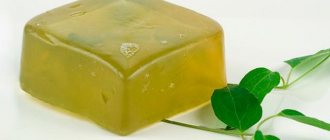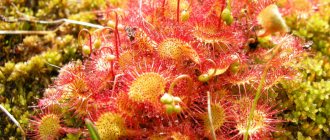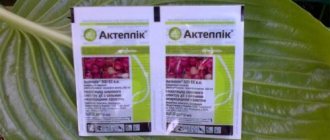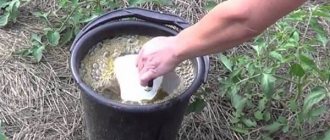How to fight pests with folk remedies
Traditional methods are most effective at the very beginning of infection, when insects have just begun to attack the plantings. In case of large-scale damage, the help of chemicals will be required.
Basic rules for making and using infusions
- Green raw materials (leaves, stems, flowers) are crushed. Then pour cold water, bring to a boil, or brew with boiling water.
- Rest for 2 – 3 hours. This time is enough for the medicinal substances to pass into the water.
- The grounds are filtered through a cloth. Add water to the infusion to the original volume.
- The liquid is filtered again so that small particles of raw materials do not clog the spray nozzle.
- Treatment of affected plants is carried out by spraying. The crowns, the lower part of the leaves, and the inner surface of the twisted leaf plates are especially carefully processed. Since pests especially like to settle in these places.
- When affected by aphids or spider mites, treatment is carried out three times, with an interval of 7–10 days. This time period is very important and should not be extended. Since this is exactly how many days it takes for an insect to develop from egg to maturity. So that new parasites do not have time to lay eggs again.
- The prepared decoction cannot be stored. It is used immediately after preparation.
How to protect flowers from a cat: how to scare away the animal
A pet in an apartment requires the attention of its owners. Dogs and cats often cause a lot of trouble for their owners. For example, cats can damage indoor plants.
They rummage through pots, “confusing” them with the tray, and chew stems and leaves. During play or due to carelessness, an animal may even turn over a pot with an indoor flower onto the floor. All this can be avoided if you think in advance about how to protect flowers from increased attention from your pet.
The problem is solved in two directions. On the one hand, it is necessary to rid the cat of the bad habit of spoiling plants, on the other hand, it is necessary to make such contacts impossible.
To wean your pet from the habit of “flirting” with flowers, you need positive reinforcement for correct behavior and negative reinforcement for prohibited actions.
An important point: you can’t hit cats. These capricious animals rarely associate physical impact with their behavior, and may simply become offended by their owners.
As a negative reinforcement, the fluffy can be slightly frightened. As soon as the owner notices that the cat is showing the “wrong” interest in a house plant, you can make a sharp sound: a whistle, a knock, a bell.
For this method to bear fruit, you will have to spend time. It is necessary to monitor every approach of the cat to the windowsill, otherwise a new conditioned reflex may not form.
You can build an unstable pyramid of tin cans near the pots. It is likely that the cat will knock it over and next time will be afraid to approach the potty.
You can scare a cat away from indoor plants using scents. Cats really don't like citrus scents. You need to take fresh lemon or orange juice, moisten a few pieces of cotton wool with it and put them in the pot. Over time, the smell disappears, which means the cotton balls need to be periodically replaced with fresh ones.
Folk recipes against aphids and spider mites
To combat garden pests, decoctions of strong-smelling herbs containing toxic substances are widely used. The general principle of preparing infusions is described above.
Marigolds (Tagetis)
The entire above-ground part of the plant is used. Raw materials are taken 0.5 kg / 10 liters of water.
Mustard powder
The powder, in the amount of 100 grams, is poured with 1 liter of boiling water.
Tops of tomatoes, potatoes, nightshade
The ratio of tops and water is 1 kg/10 liters. Mandatory condition: the green mass must be without signs of spoilage or fungal infections. Otherwise, there is a risk instead of benefit, spreading fungal diseases throughout the area.
Wood ash (recipe 1)
- Pour sifted ash (3 kg) into a bucket of cold water and leave for 2 days.
- Strain thoroughly before use.
In addition to the repellent effect, the infusion of ash will work as a foliar feeding.
Wood ash (recipe 2)
Use the same amount of ingredients, but add boiling water. Can be used after 3 – 4 hours.
Ash and soap bathing
Effectively helps against aphids. The tops of infected plants are lowered into a container with a solution and washed manually. Even a single bath will get rid of a significant number of insects.
Take a solution prepared according to any method described above. Add 300 grams of planed laundry soap. You can use liquid green soap - 130 ml.
Tobacco dust
Tobacco dust powder, or dry parts of the plant – 200 g, steam with 5 liters of boiling water. After cooling, bring to 10 l.
Pine needles
Pine needles additionally have a stimulating effect. Pour 1 kg of pine or fir needles with 4 liters of water. Leave for a week, stirring occasionally. Dilute the prepared liquid by half before use.
The most common flower diseases
There are many diseases that affect flowers. Some of them are rare, others can be found in almost every garden. The most common “illnesses” of flowers include:
- powdery mildew;
- rust;
- gray rot;
- spotting.
Powdery mildew
It manifests itself as a white, ashy or grayish coating on the leaves, which can subsequently turn brown. First, faint whitish spots appear, then the affected area increases and gradually covers the entire diseased plant. The upper side of the leaves is more affected. This disease is caused by a number of fungal species. It develops more actively during periods of inclement wet weather, but can appear on flowers even when air humidity is 70% or less. Among flower crops, phlox and chrysanthemums, lupins and gillyflowers, as well as geraniums, delphiniums, calendula and many other species often suffer from powdery mildew.
Ways to combat powdery mildew of flowers:
- We mentioned prevention above - it is necessary to promptly prune plants that have bloomed, as well as tear off and destroy leaves or stems covered with spots.
- In autumn or at the very beginning of spring, after removing diseased stems and harvesting dead leaves, you need to spray perennials before the leaves appear with a 1-2% solution of iron or copper sulfate. For those perennial plants that overwinter with leaves, treatment with 1% Bordeaux mixture is suggested.
- During the growing season, except for the period when flowers bloom, if characteristic signs of powdery mildew are detected, the plant is sprayed with “Topaz” or “Skor”. Effective treatment is also ensured by the use of fungicides such as Fundazol and Raek. It is recommended to use them alternately, mixing water-soluble fertilizers into the product solutions in order to immediately perform foliar feeding.
Rust
This disease can spread in some types of flowers exclusively on the leaves, while in others it affects both shoots and buds. Small pads are formed on them, the color of which varies. This is what pustules look like, containing fungal spores that provoke the appearance of rust on plants. If no action is taken, the pustules will spread over most of the plant's leaves and stems, turning pale green, yellow, or brown around the pustules. Over time, the leaves will fall off, the stems will become deformed, and the plant will die. The most susceptible to rust are mallow and carnation; resistant varieties of flowers include white phlox.
This disease must be dealt with as follows:
- Choose varieties of flowers that are resistant to this scourge for planting.
- Remove affected leaves and shoots, remove flying ones, destroy parts of diseased plants by burning.
- For the purpose of prevention, spray the plantings with Abiga-Pik or another preparation containing copper - for example, 1% Bordeaux mixture, Ordan or Khomom products, copper oxychloride, etc. - during the period of the beginning of the growth of biennial or perennial flowers that suffered from rust last season. This treatment should be repeated periodically throughout the growing season when foci of rust are detected, changing the preparations.
- It is recommended to feed flowers with fertilizers with a high potassium content, this improves the plant's immunity.
Gray rot
The disease is caused by fungi that colonize all parts of many flower crops, including their roots, and begin to parasitize them, causing a brown color change, softening and rotting. Plants are covered with a characteristic thick gray coating consisting of fungal colonies. Because of this plaque, the disease got its name. It occurs at different stages of the growing season, but in the second half of summer it is detected more often.
First of all, gray rot appears on weak shoots, but if you do not fight it, it quickly covers the entire area.
Almost all types of flower crops are susceptible to this disease. The pathogen successfully overwinters on the remains of affected flowers. It develops at almost any above-zero temperature. Dry weather slows its spread. Increased air humidity and excessive density of flower beds contribute to the intensification of the spread of the disease.
Flower crops such as tulips and lilies, dahlias and gladioli, lupins, peonies, geraniums, roses, chrysanthemums, etc. are especially susceptible to the causative agent of gray rot. These types of flowers do not have varieties with increased resistance to gray rot.
In the fight against this disease, the emphasis is on creating unfavorable conditions for the life of the causative fungus. Measures being taken include:
- Thinning thickened plantings to ensure good ventilation.
- Careful care of flowers, preventing accidental mechanical damage to all parts of the plants.
- Carefully dosed watering without waterlogging the soil.
- Feeding with fertilizers containing phosphorus and potassium. These elements increase the resistance of flowers to disease.
- Periodic loosening of the soil.
- Timely removal and destruction of diseased leaves and stems. When pruning, it is necessary to retreat 5-10 cm lower from the last border of the lesion; if the spread is widespread, the plant is completely removed.
- Preventive spraying of flowers at intervals of 10-12 days with any preparations containing copper - for example, “Abiga-Pik”, “Oxychom” or “Ordan”. During flowering, preventive spraying is not carried out. If foci of the disease are discovered during this period, the flowers can be watered with Profit Gold, diluted to a concentration of 5 g per bucket of water. For each affected bush, 0.2 liters of working solution is consumed.
Planting material must be treated with a growth stimulator, this will increase resistance to disease.
spotting
It begins with the appearance of mild spots on the leaves, gradually they increase in size, and the disease affects all parts of the plant. The shape of the resulting spots can be any, the color is predominantly brown or brown, often with a bright border. Often the leaves look holey. With further development of the disease, the flowers dry out and fall off. Spotting is caused by individual fungi and a number of bacteria. The unfavorable conditions in which flowers are grown contribute to its development. The disease spreads with water, air currents moved by the wind, and carried by insects. Most often, spots of fungal and bacterial origin affect irises and chrysanthemums, peonies and lupins, delphiniums and primroses.
How to resist flower spotting:
- take preventive measures - alternating types of flowers in the garden, competently destroying diseased plants and weeds, eliminating insects that carry pathogens;
- carry out active treatment - spraying flowers with such agents as “Skor”, Hom, oxychloride and copper oxychloride, “Ordan” or “Fundazol”.
Codling moths, moths, copperheads, sawflies, small caterpillars
Preventive spraying is carried out during the flowering period, during the summer of butterflies: every 5 days.
Sagebrush
Steam a kilogram of bitter herb with a bucket of boiling water. After cooling, strain.
Red hot pepper
Prepare an infusion from 1 kg of fruit and 10 liters of water, strain, and put in a cool, dark place. To spray, dilute 500 ml of liquid with ten liters of water.
Onion
Chop 100 g of onion, add 1 liter of cold water, leave without boiling for 24 hours.
Clean the cat's litter box
If your cat uses pots with soil and plants as a toilet, then you need to pay attention to the cleanliness of her litter box. It is possible that you rarely clean it. Try to replace the filler and remove dirt on time.
Seven daily habits of happy people
Only on a soft spot: Russian Domostroy forbade punishing children in any other way
The star of the series “Sultan of My Heart” spoke about the choice of his future wife
Sometimes cats refuse to go into a clean litter box, but show interest in flower pots. In this case, you need to choose a different type of cat litter.
Ways to combat Colorado potato beetles
Mixtures prepared independently are aimed at repelling adult insects. Treatment is carried out before the appearance of beetles and during their summer.
Walnut leaves
Dry leaves (2 - 3 kg), add 10 liters of water, infuse for 3 - 5 days.
Birch tar
Dilute a 100 ml bottle of tar in a bucket of water. Spray potato tops every 2 - 3 days. You can use tar soap - 100 g bar.
Multicomponent mixture
Pour all ingredients into a bucket of water and bring to a boil. After 12 hours you can use it by thoroughly watering the leaves.
Compound:
- wormwood - 0.3 kg;
- hot pepper (powder) - 1.5 tablespoons;
- garlic - 0.2 kg;
- soap - 50 g;
- hemlock - 0.2 kg
Placiterium staghorn
If you have a cat at home, then try to choose suitable types of plants for landscaping. For cat owners, the staghorn fern is ideal. In nature, it grows on tree trunks and branches. At home, platicerium is grown on vertical blocks that can be mounted high on the wall.
What is worth seeing in Sao Paulo: the inimitable Ibirapuera Park
Traveling for your love: what type of vacation to choose to strengthen your relationship
The penalty for laziness: how to maintain high productivity with low motivation
Platycerium staghorn is an unpretentious plant. It requires watering only once a week. The leaves of this fern contain no toxins and are safe for cats.
Options for getting rid of pests of indoor plants
In an apartment, the choice of method is not as wide as in open ground.
When processing home flowers, special attention is paid to shelves, windows, window sills, and flowerpots. That is, those places that come into contact with the plant. They should also be washed well. Because they may contain insects or eggs, which will become a source of new infection.
Laundry soap
The most common laundry soap showed the greatest effectiveness. Regular “bath days” using soap foam are an excellent prevention of the spread of parasites.
Soap foam is applied to specimens affected by spider mites or aphids. Then after 5-10 minutes everything is washed off with a soft sponge under a cool shower.
Alcohol
Alcohol helps against spider mites. Use a cotton pad soaked in alcohol to wipe the infected leaves. The procedure is carried out as ticks are detected.
Garlic infusion
Chopped garlic clove 5 grams, leave for 24 hours in a liter of cold water. Wipe or spray the leaves with a fresh solution. Use against aphids, scale insects, whiteflies.
Tansy
Brew a tablespoon of dry tansy (sold at the pharmacy) with 1.5 liters of boiling water. After cooling, strain. Treat against scale insects, scale insects, and aphids.
If protecting your garden and garden from pests using folk methods does not bring any effect, or it is not very convenient to use them, for example, in large collections, there is always the possibility of using chemicals. An article about industrial products will help you decide on the choice of a suitable drug.
Whitefly
This is an insect with a body length of no more than 2 mm. A characteristic feature is white wings and a yellowish body. They can be found:
- On the back side of the leaves, where they are located in colonies.
- According to characteristic sweetish traces, on which after some time a sooty fungus appears.
Whitefly larvae have a sucking type of mouthparts, so they suck out the juices from the plant. As a result, the plant loses its vitality and gradually loses its attractiveness. If no measures are taken, the plant will soon die.
Interesting fact! When appearing in greenhouses, the whitefly prefers plants such as hibiscus, pelargonium or begonia. After the appearance of just one individual, after a short period of time a whole colony of these insatiable pests appears in the greenhouse. In this regard, the fight should begin immediately.
Saving indoor plants from pests and diseases - Everything will be fine - Issue 282 - 11/05/2013











